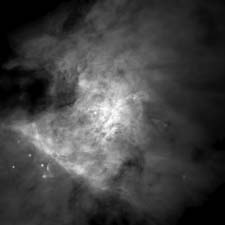Return to Index |
Previous Image |
Next Image |
The Orion nebula
is a stellar nursery, filled with young stars and gas. 1,500 light years
away, it is the closest region of its type to the Earth. Orion is an emission
nebula, meaning that it is many light years across and very large in comparison
to other types of nebulae. Located in the middle of Orion the Hunter's
sword, the Orion nebula is actually part of a much larger cloud of gas
and dust that covers a majority of the Orion constellation. The giant
gas cloud is illuminated by the young hot stars it produces. Many of the
stars that appear fainter are encapsulated by disks of gas and dust. The
diagonal length of the region is roughly 1.6 light years. On a clear winter
night outside the Chicago area, you can see with your naked eye the Orion
Nebula as a fuzzy wisp in Orion's sword. This image shows the central
part of this great stellar nursery. Four bright, hot and young stars are
responsible for exciting the gas clouds in the nebula. The atoms in the
cloud have a high a temperature and are energized by ultraviolet light
from a nearby star and emit radiation as they fall back into lower energy
levels. (Courtesy of NASA's Hubble Space Telescope).
References:
http://oposite.stsci.edu/pubinfo/gif/OrionFull.txt
http://seds.lpl.arizona.edu:80/billa/twn/n1976x.html
Object |
Distance from Earth |
Wavelength |
Orion
Nebula |
1,500
light years |
Optical |

